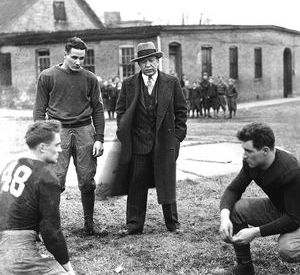Tradition Is a Guide, and Not a Jailer

National Signing Day has come and gone and Notre Dame football fans around the country continue to recover from the hangover of the one last hurrah before the inevitable off-season lull. Broken only briefly by a short-lived Spring “dog and pony show” in which only die-hard fans trek to Notre Dame Stadium to brave the unpredictable northern Indiana weather and catch a glimpse of what next year could bestow, the off-season provides little opportunity for discussion other than fantasy-based prognostication. Most of these superfluous discussions center around how Notre Dame football is progressing into the future or still holding onto the past. Topics such as future schedules, the hiring and firing of coaches (whenever applicable), new players, and the general hindsighting of what could have been or what could yet be fill news outlets, magazines, newspapers, blogs, and living rooms around the country.
While most headlines between the end of December and the end of January center around recruiting, last Sunday, Eric Hansen of the South Bend Tribune provided us with this little gem of an interview with Notre Dame Athletic Director Jack Swarbrick. And while his article mostly centers around the future of Notre Dame athletics, towards the end of the interview the discussion hones in, albeit briefly, on the football program and the condition of Notre Dame Stadium, namely the condition of the field and whether or not a “video board” (read: Jumbotron) should be installed and used during football games or other events such as graduation.
While the discussion about the installation of a Jumbotron isn’t as prevalent among fans as, say, Notre Dame’s Independent status, or if future schedules should be as tough as they are, most traditionalists adopt the position of not making any significant changes to the way Notre Dame has always done things: the same is true on the issue of electronics and artificial field turf.
Installing a screen that projects advertisements, neon lights, and graphics, and something that may further obstruct the view of the “Word of Life” mural on the front of the Hesburgh Memorial Library, has many “traditionalists” squirming in their seats. However, the other side of the aisle believes that the installation of a Jumbotron or, probably even more importantly, the installation of artificial turf or field grass in the stadium serves to keep Notre Dame up to speed with the current pace of college football.
The tradition at Notre Dame is second to none. However, this same tradition, especially as it pertains to football, was forged in the belief that the University should be the first and the greatest. Many of the traditions that fans embrace regarding Notre Dame football were established by its forefathers as cutting-edge philosophies. They did not react to others changing college football, they initiated change. And as Notre Dame, as a University, has walked the political tight-rope between change and tradition, this is something that its supporters have lost sight of.
To say that Notre Dame shouldn’t implement changes to its facilities, scheduling, coaches, or operations is to say that it should undermine the philosophies of those icons that helped mold Notre Dame Football into what it is today. We have been gripping tightly to the traditions themselves, rather than honoring the attitudes that established those traditions in the first place.
If Knute Rockne or Frank Leahy were coaching the Irish today, would they want a Jumbotron, new turf, or scheduling format changes? Who knows? Jumbotrons and artificial turf, in the grand scheme of things, are fairly small potatoes and shouldn’t be at the top of Jack Swarbrick’s to-do list. And the problems that deserve to be addressed within Notre Dame’s athletics, and football in particular, are far more worthy of his attention than electronics and synthetics.
Notre Dame fans themselves aren’t overly unwilling to give things up, or accept changes in things that they have an emotional attachment to. The real problem in this debate lies in some fans failure to see why those things to which they have an emotional attachment were established in the first place.

